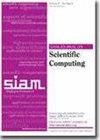用于大规模时空贝叶斯建模的集成嵌套拉普拉斯近似法
IF 2.6
2区 数学
Q1 MATHEMATICS, APPLIED
引用次数: 0
摘要
SIAM 科学计算期刊》,第 46 卷第 4 期,第 B448-B473 页,2024 年 8 月。 摘要。贝叶斯推理任务继续对计算提出挑战。时空建模尤其如此,因为高维潜在参数空间无处不在。集成嵌套拉普拉斯近似(INLA)方法提供了一个进行贝叶斯推断的框架,适用于一大类加法贝叶斯层次模型。它与随机偏微分方程(SPDE)方法相结合,产生了一种高效的时空建模方法。在这项工作中,我们在 INLA-SPDE 方法的基础上,提出了一种适用于大规模应用的高性能分布式内存变体 INLADIST。为了执行由 Cholesky 因子化、线性系统求解和选定矩阵反演组成的计算内核操作,我们提出了两种数值求解器方案:一种是基于 CPU 的稀疏库,另一种是我们提出的新型阻塞式 GPU 加速方案。我们利用所产生的精度(逆协方差)矩阵中反复出现的非零块结构,这使我们能够在稀疏设置中使用密集子程序。INLADIST 的两个版本都具有很强的可扩展性,能够对具有数百万个潜在参数的模型进行推理。我们在合成和实际气候数据集应用中展示了它们的准确性和性能。本文章由计算机程序翻译,如有差异,请以英文原文为准。
Integrated Nested Laplace Approximations for Large-Scale Spatiotemporal Bayesian Modeling
SIAM Journal on Scientific Computing, Volume 46, Issue 4, Page B448-B473, August 2024.
Abstract. Bayesian inference tasks continue to pose a computational challenge. This especially holds for spatiotemporal modeling, where high-dimensional latent parameter spaces are ubiquitous. The methodology of integrated nested Laplace approximations (INLA) provides a framework for performing Bayesian inference applicable to a large subclass of additive Bayesian hierarchical models. In combination with the stochastic partial differential equation (SPDE) approach, it gives rise to an efficient method for spatiotemporal modeling. In this work, we build on the INLA-SPDE approach by putting forward a performant distributed memory variant, INLADIST, for large-scale applications. To perform the arising computational kernel operations, consisting of Cholesky factorizations, solving linear systems, and selected matrix inversions, we present two numerical solver options: a sparse CPU-based library and a novel blocked GPU-accelerated approach which we propose. We leverage the recurring nonzero block structure in the arising precision (inverse covariance) matrices, which allows us to employ dense subroutines within a sparse setting. Both versions of INLADIST are highly scalable, capable of performing inference on models with millions of latent parameters. We demonstrate their accuracy and performance on synthetic as well as real-world climate dataset applications.
Abstract. Bayesian inference tasks continue to pose a computational challenge. This especially holds for spatiotemporal modeling, where high-dimensional latent parameter spaces are ubiquitous. The methodology of integrated nested Laplace approximations (INLA) provides a framework for performing Bayesian inference applicable to a large subclass of additive Bayesian hierarchical models. In combination with the stochastic partial differential equation (SPDE) approach, it gives rise to an efficient method for spatiotemporal modeling. In this work, we build on the INLA-SPDE approach by putting forward a performant distributed memory variant, INLADIST, for large-scale applications. To perform the arising computational kernel operations, consisting of Cholesky factorizations, solving linear systems, and selected matrix inversions, we present two numerical solver options: a sparse CPU-based library and a novel blocked GPU-accelerated approach which we propose. We leverage the recurring nonzero block structure in the arising precision (inverse covariance) matrices, which allows us to employ dense subroutines within a sparse setting. Both versions of INLADIST are highly scalable, capable of performing inference on models with millions of latent parameters. We demonstrate their accuracy and performance on synthetic as well as real-world climate dataset applications.
求助全文
通过发布文献求助,成功后即可免费获取论文全文。
去求助
来源期刊
CiteScore
5.50
自引率
3.20%
发文量
209
审稿时长
1 months
期刊介绍:
The purpose of SIAM Journal on Scientific Computing (SISC) is to advance computational methods for solving scientific and engineering problems.
SISC papers are classified into three categories:
1. Methods and Algorithms for Scientific Computing: Papers in this category may include theoretical analysis, provided that the relevance to applications in science and engineering is demonstrated. They should contain meaningful computational results and theoretical results or strong heuristics supporting the performance of new algorithms.
2. Computational Methods in Science and Engineering: Papers in this section will typically describe novel methodologies for solving a specific problem in computational science or engineering. They should contain enough information about the application to orient other computational scientists but should omit details of interest mainly to the applications specialist.
3. Software and High-Performance Computing: Papers in this category should concern the novel design and development of computational methods and high-quality software, parallel algorithms, high-performance computing issues, new architectures, data analysis, or visualization. The primary focus should be on computational methods that have potentially large impact for an important class of scientific or engineering problems.

 求助内容:
求助内容: 应助结果提醒方式:
应助结果提醒方式:


